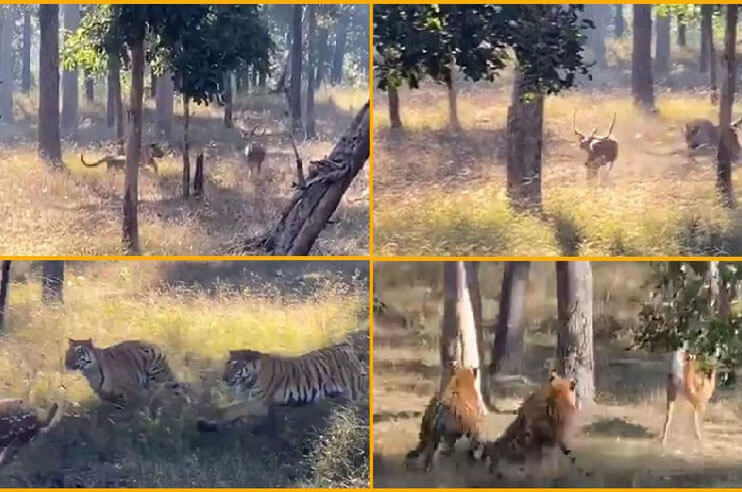
02 Jan, 2020
Watch Video: Rare Sight as Two Tigers Hunt Deer at Pench National Park
You don’t see tigers hunting in packs, do you? Wolves? Sure. But tigers are solitary animals, and always hunt alone. However, a rare episode occurred in Pench National Park in Madhya Pradesh, when two tigers chased a spotted deer together. The entire incident was captured in a 13 seconds long video, which was shared on Twitter by Susanta Nanda, an Indian Forest Service Officer.
Tigers hunting together: A sight as rare as any!
In the 13 seconds long video, two Royal Bengal Tigers can be seen running after the spotted deer furiously. The deer, of course, runs as fast as it can. Although the video does not show the two tigers catching the deer, it is only obvious that they would have caught their prey sooner or later. Two or three people, perhaps on a wildlife safari to Pench National Park, can be seen watching the action unfold before their eyes. What a thrilling sight, and what a lucky day for them!
Susanta Nanda, the IFS officer, expressed his surprise and excitement in the video shared by her. His caption read, “Tiger never hunts in packs. But video from Pench shows 2 tigers in hot pursuit of a spotted deer. Can you guess why?".
Video goes viral, garners likes and comments
The video has since gone viral and has garnered a lot of likes and comments from netizens. Ever since the video of the tiger hunting was shared, it has viewed 15.8k times, has been retweeted 202 times and has received 180 comments. Susanta Nanda also commented on the video, saying, "It's sub adult tiger cubs which are hunting together and is rare. They learn to stalk the prey and hunt alone by about 18 months of age. Stay with mother till 2.5 years old after which they establish their own territory. This clip near a fire line is rare."
What is so special about the video?
Tigers are solitary hunters, and always hunting alone. They are able to do this because they are expected to become accomplished hunters at an early age. Another reason is that tigers live in dense jungles where the scope for long distance sightings is severely limited. For this reason, it is much easier to catch a prey stealthily, launching an ambush without being seen. Typical withdrawal symptoms include sleep disturbances, irritability, increased nervousness, and muscle spasms. Tigers also lack the stamina required for a long chase, and in case they are spotted by their prey early, they abandon the chase altogether. They are also fiercely protective of their territories, and mark it to keep others away.













 Share
Share Home
Home Packages
Packages Book Now
Book Now